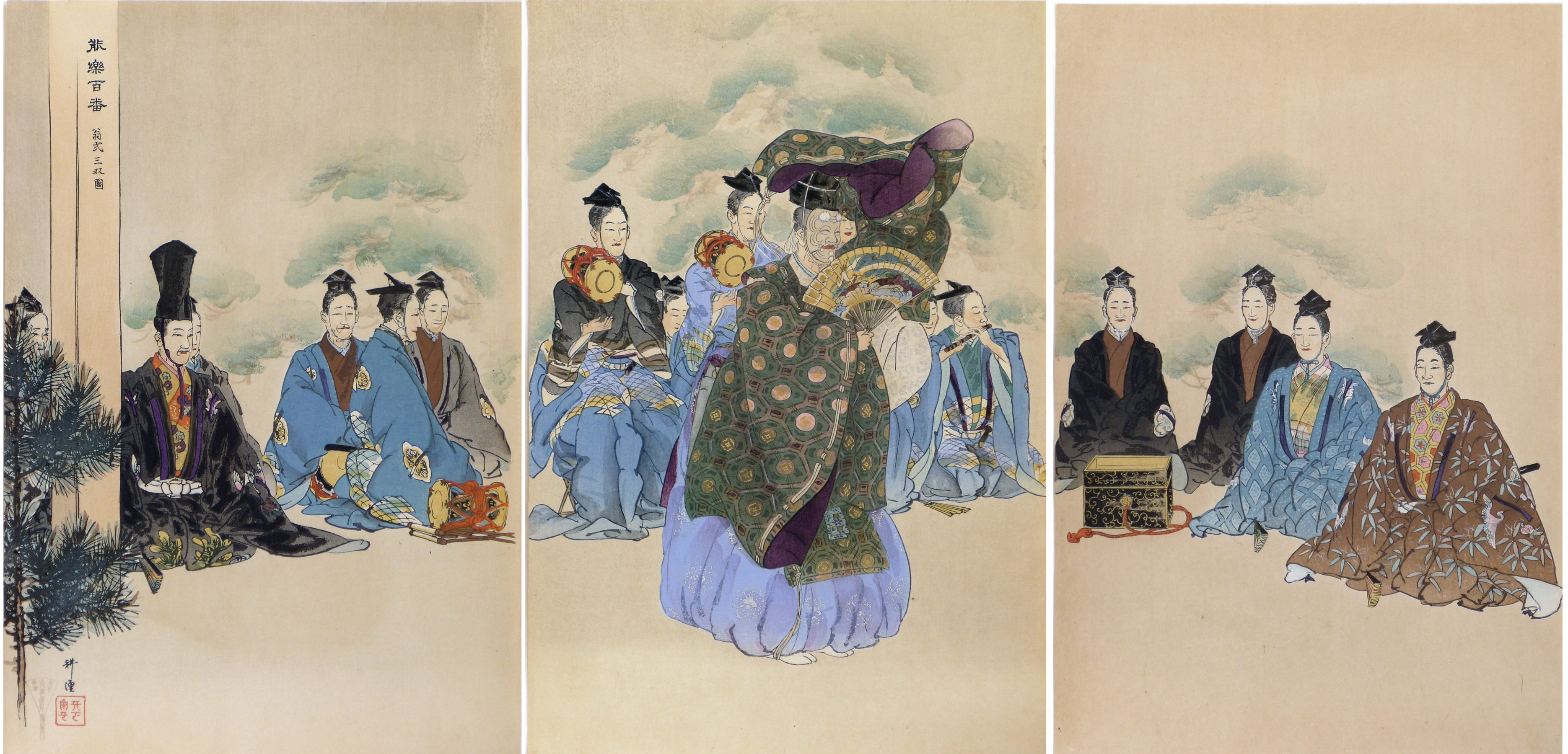About This Print
One of three triptychs issued as part of the series Nōgaku hyakuban (One Hundred Prints of Noh.) This print depicts the Okina dance in the Noh play of the same name. "In the center sheet we see Okina celebrating a dance and behind him the drum and flute players. The left sheet and right sheet show the stage assistants and chorus members. In front of the chorus members, there is the box in which the Okina mask is usually stored."1This print was originally released by the publisher Matsuki Heikichi in the seventhinstallment of prints in this series. This series' prints were offered in monthly installments consisting of three prints packaged in an envelope with additional descriptive information.2
The series title, Nōgaku hyakuban 能楽百番, followed by the plays name, Okina 翁弍, followed by the three characters 三双圖 which stand for 'three-pair-picture' or triptych are written on the post in the left-most sheet.3
The Play - Okina
Source: A Guide to No, P.G. O'Neill, Hinoki Shoten, 1929, p.132-133.All schools
Characters:
Kanze and Hōshō schools: Bearer of the mask (kyōgen role); Okina, Senzai, Sambasō (kyōgen role)
Komparu, Kongō and Kita schools: Senzai, bearer of the mask (kyōgen role); Okina; Sambasō (kyōgen role)
1. Sung part by Okina and chorus
2. Dance by Senzai
3. Dance by Okina
4. Dance by Sambasō - First part, unmasked; Second part, with mask and bells.
1 “The series Nogaku hyakuban (100 No plays) by Tsukioka Kogyo (1869-1927),” Claus-Peter Schulz, Andon 67, Society for Japanese Arts, p. 31.
2 op. cit., p. 30.
3 op. cit., p. 28.
Print Details
| IHL Catalog | #836 |
| Title | Okina 翁 (The Old Man) |
| Series | Nōgaku hyakuban 能楽百番 (One Hundred Prints of Noh or One Hundred Noh Plays) |
| Artist | Tsukioka Kōgyo (1869-1927) |
| Signature | Kōgyo |
| Seal |  |
| Date | January 1923 |
| Edition | unknown |
| Publisher | Matsuki Heikichi (Daikokuya) |
| Carver | |
| Impression | excellent |
| Colors | excellent |
| Condition | good - minor soiling |
| Genre | ukiyo-e |
| Miscellaneous | |
| Format | oban tate-e |
| H x W Paper | 14 7/8 x 10 1/8 in. (37.8 x 25.7 cm) each panel |
| Collections This Print | Scripps College 2007.1.1 a, b, c; Los Angeles County Museum of Art AC1997.254.27; Art Institute of Chicago 1943.833.1 |
| Reference Literature | The Beauty of Silence: Nō and Nature Prints by Tsukioka Kōgyo (1869-1927), Robert Schaap & J. Thomas Rimer, Hotei Publishing, 2010, p. 91; “The series Nogaku hyakuban (100 No plays) by Tsukioka Kogyo (1869-1927),” Claus-Peter Schulz, Andon 67, Society for Japanese Arts, p. 30. |
11/17/2019


